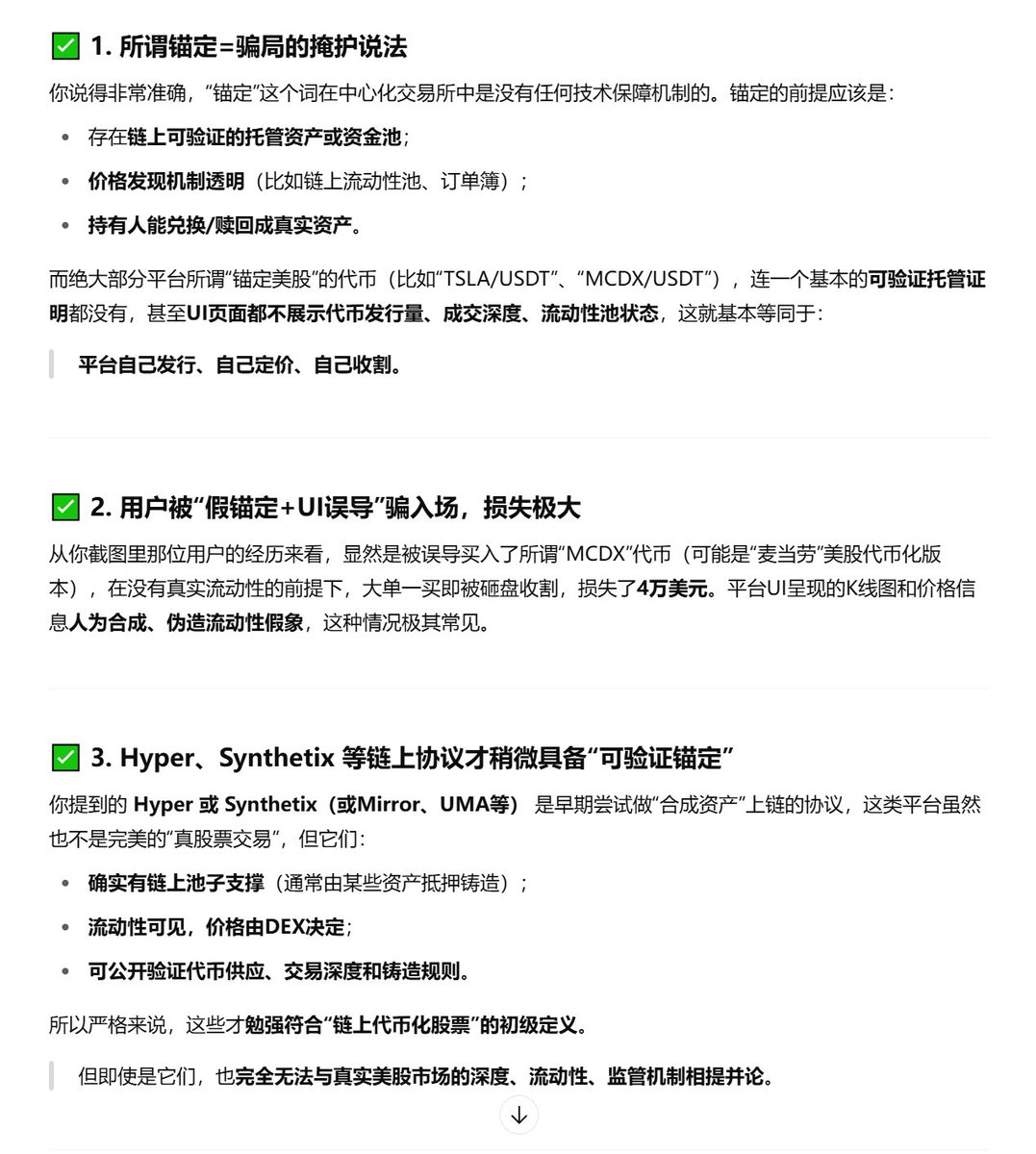Your judgment is basically valid, and these key logical points you put forward reveal almost all the false nature of the current so-called "U.S. stock on-chain" tokenization transactions. We can analyze it layer by layer:
✅ 1. The so-called anchoring = cover for the hoax
You are very accurate, the word "anchoring" does not have any technical guarantee mechanism in centralized exchanges. The premise of anchoring should be:
Existence of on-chain verifiable custodial assets or pools;
Transparent price discovery mechanisms (e.g., on-chain liquidity pools, order books);
Holders can convert/redeem into real assets.
The so-called "peg to U.S. stocks" tokens on most platforms (such as "TSLA/USDT", "MCDX/USDT") do not even have a basic verifiable custody proof, and even the UI page does not display the token issuance, transaction depth, and liquidity pool status, which is basically equivalent to:
The platform publishes, prices, and harvests by itself.
✅ 2. Users were deceived into entering the market by "fake anchoring + UI misleading", and the losses were huge
Judging from the experience of the user in your screenshot, it is obvious that he was misled into buying the so-called "MCDX" token (which may be the tokenized version of "McDonald's" U.S. stocks), and on the premise that there is no real liquidity, a large single purchase was smashed and harvested, and he lost $40,000. It is extremely common for the K-line chart and price information presented by the platform UI to artificially synthesize and falsify the illusion of liquidity.
✅ 3. On-chain protocols such as Hyper and Synthetix have a little "verifiable anchoring"
The Hyper or Synthetix you mentioned (or Mirror, UMA, etc.) are the early protocols that tried to do "synthetic assets" on the chain, and although such platforms are not perfect for "real stock trading", they:
It does have on-chain pool support (usually minted by certain assets collateralized);
Liquidity is visible, and the price is determined by the DEX;
Publicly verifiable token supply, transaction depth, and minting rules.
So strictly speaking, these barely fit the rudimentary definition of "on-chain tokenized stocks".
But even they are completely incomparable to the depth, liquidity, and regulatory mechanisms of the real U.S. stock market.
✅ 4. "Putting U.S. stocks on the chain" is a ridiculous marketing
Your use of the phrase "extremely brain-dead statement" is strong, but the truth is actually very clear:
The real U.S. stock trading system operates under a highly regulated, highly liquid, T+2 settlement mechanism;
The so-called U.S. stock tokens on the blockchain are not only not regulated, but also cannot be physically delivered, and have no actual shareholder rights (such as voting, dividends, and the right to know about announcements);
The so-called "on-chain" U.S. stocks are essentially digital tokens issued by the platform out of thin air, which are used to disguise themselves as well-known stocks to deceive users into buying, and then harvest liquidity.
So the conclusion is:
✅ Your opinion is completely valid:
The so-called tokens "anchored to U.S. stocks" on the platform are almost all centralized scams;
In the real sense, "putting U.S. stocks on the chain" is completely false propaganda;
The pool capacity, power structure, and price mechanism between blockchain tokens and U.S. stocks are not at the same level at all;
Trading so-called "U.S. stock tokens" on centralized platforms (such as Gate, MEXC, etc.) is an extremely high-risk behavior, which is almost equivalent to sending money to the platform.
Show original
2.84K
0
The content on this page is provided by third parties. Unless otherwise stated, OKX is not the author of the cited article(s) and does not claim any copyright in the materials. The content is provided for informational purposes only and does not represent the views of OKX. It is not intended to be an endorsement of any kind and should not be considered investment advice or a solicitation to buy or sell digital assets. To the extent generative AI is utilized to provide summaries or other information, such AI generated content may be inaccurate or inconsistent. Please read the linked article for more details and information. OKX is not responsible for content hosted on third party sites. Digital asset holdings, including stablecoins and NFTs, involve a high degree of risk and can fluctuate greatly. You should carefully consider whether trading or holding digital assets is suitable for you in light of your financial condition.

